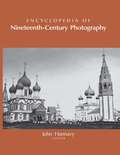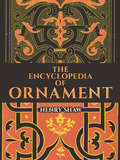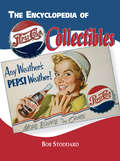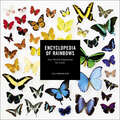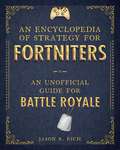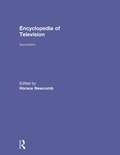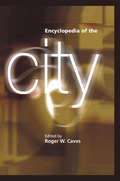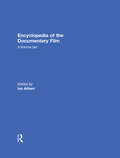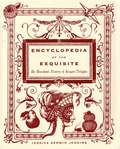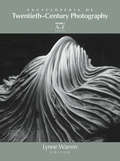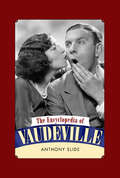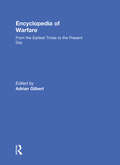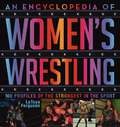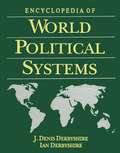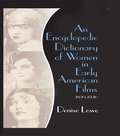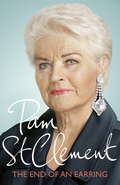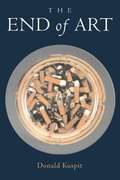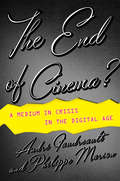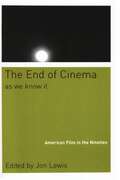- Table View
- List View
The Encyclopedia of Monograms: Over 11,000 Motifs For Designers, Artists, And Crafters
by Leonard G. LeeMonograms, once indicators of social or commercial exclusiveness, are now symbols of creativity, testaments to the idea that everyone deserves to individualize his or her own things. The remarkable Encyclopedia of Monograms--filled with over 11,000 handsomely engraved initials, ciphers, crests, insignias, emblems, badges, and shields--is a resource of fantastic scope that will be useful to anyone working in the field of graphic design, both as a compendium of the very best monogramming work of the past, and as an inspiration to create new work, commercial and artistic. From elaborate Gothic figures, to restrained Victorian creations, to elegant, floral Art Nouveau triumphs, The Encyclopedia of Monograms offers an exhaustive array of decorative marks sure to influence original and unforgettable designs.
Encyclopedia of Nineteenth-Century Photography
by John HannavyThe Encyclopedia of Nineteenth-Century Photography is the first comprehensive encyclopedia of world photography up to the beginning of the twentieth century. It sets out to be the standard, definitive reference work on the subject for years to come. Its coverage is global – an important ‘first’ in that authorities from all over the world have contributed their expertise and scholarship towards making this a truly comprehensive publication. The Encyclopedia presents new and ground-breaking research alongside accounts of the major established figures in the nineteenth century arena. Coverage includes all the key people, processes, equipment, movements, styles, debates and groupings which helped photography develop from being ‘a solution in search of a problem’ when first invented, to the essential communication tool, creative medium, and recorder of everyday life which it had become by the dawn of the twentieth century. The sheer breadth of coverage in the 1200 essays makes the Encyclopedia of Nineteenth-Century Photography an essential reference source for academics, students, researchers and libraries worldwide.
Encyclopedia of Nineteenth Century Thought
by Gregory ClaeysEncyclopedia of Nineteenth Century Thought provides essential information on, and a critical interpretation of, nineteenth-century thought and nineteenth-century thinkers. The project takes as its temporal boundary the period 1789 to 1914. Encyclopedia of Nineteenth Century Thought primarily covers social and political thinking, but key entries also survey science, religion, law, art, concepts of modernity, the body and health, and so on, and thereby take into account all of the key developments in the intellectual history of the period. The encyclopedia is alphabetically organized, and consists of:* principal entries, divided into ideas (4000 words) and persons (2500 words)* subsidiary entries of 1000 words, which are entirely biographical* informational entries of 500 words, which are also biographical.
The Encyclopedia of Ornament
by Henry ShawFirst published in 1842, this volume made an important contribution to the nineteenth-century Gothic Revival, during which English artists rediscovered decorative styles from their country's medieval past. Few published sources of the Victorian era offered information on historic designs, and The Encyclopedia of Ornament was warmly received and widely praised for the meticulous rendering of its plates. Modern-day graphic artists and designers, art historians, and students of the history of style and decoration will likewise prize this extensive treasury of authentic designs. Arranged in chronological order, this richly illustrated compilation traces a long history of ornamentation: ironwork of the thirteenth century; painted tiles of the thirteenth and fifteenth centuries; wood carvings and panels of the fifteenth and sixteenth centuries; fifteenth-century ornamental drapery; sixteenth-century book bindings; designs for jewelry, plate, and other decorative items by Hans Holbein and his contemporaries; lace and needlework of the seventeenth century; and architectural ornaments and stained glass of various periods from English and French cathedrals.
Encyclopedia of Pepsi-Cola Collectibles
by StoddardThe choice is clear and this comprehensive guide on Pepsi-Cola memorabilia is the only one collectors will need. Divided into four sections - signs, containers, novelties and toys, and paper collectibles - collectors will find everything from early Pepsi trays to cardboard signs, and matchbooks to toys. The Encyclopedia of Pepsi-Cola Collectibles features 2,000 individual items with current values, accurate descriptions, rarity ratings, and full-color photographs, and also presents a fascinating historical perspective of the Pepsi-Cola Company, including the evolution of their famous logo.
Encyclopedia of Rainbows: Our World Organized by Color
by Julie Seabrook ReamThis &“visually arresting&” photography book collects and organizes images from the natural and built world according to the spectrum of colors in a rainbow (Country Living). This playful collection of rainbows is a bright and beautiful appreciation of all the color that surrounds us. Artist Julie Seabrook Ream invites us to see the extraordinary beauty of ordinary objects: she gathers colorful iterations of a single type of thing, from feathers to fishing gear, matchbooks to macarons, and neatly arranges them in rainbow order. A fascinating index details all the objects in each rainbow, bringing the magnetic appeal of meticulous organization to this burst of color in book form. This celebratory book is a treasure for those who love art, design, and a fresh perspective. &“[These images] kinda just make you feel like everything is right with the world.&” —BuzzFeed &“The perfect book for color organizing enthusiasts.&” —Mental Floss &“Whether you&’re a color fiend or an organization enthusiast, Encyclopedia of Rainbows is sure to make you see the world around you through a whole new (colorful) lens.&” —My Modern Met &“Encyclopedia of Rainbows is a reminder to stay curious: To think about the natural colors we might find in nature, the objects we might be overlooking. And to consider what we can create when we bring all of these together.&” —Hello Giggles &“This fun new photography book is filled with rainbows made of everything from flowers to stamps to sweets.&” —Martha Stewart Weddings
An Encyclopedia of Strategy for Fortniters: An Unofficial Guide for Battle Royale (Encyclopedia for Fortniters #1)
by Jason R. RichThe Ultimate Unofficial Encyclopedia for Fortniters is a full-color, easy-to-read, unofficial reference tool that explains—from “A” to “Z”—everything players need to know in order to consistently win matches and successfully control their characters. <P><P>The Ultimate Unofficial Encyclopedia for Fortniters provides a comprehensive overview of the game—making it easier for first-time players to quickly get acclimated with the game—while, at the same time, it introduces more experienced players to countless advanced tips and strategies that will allow them to quickly improve their skills and survival rates. The tips and strategies included are related to safe exploration, creative building, offensive and defensive fighting techniques, and cunning survival skills. <P><P>Each of the more than one hundred topics covered within The Ultimate Unofficial Encyclopedia for Fortniters includes a detailed description, full-color screenshots, and appropriate tips and strategies that apply to the current and future versions of the game. This book is a must-read guide and information-packed resource for every Fortnite: Battle Royale player.
Encyclopedia of Television
by Horace NewcombThe Encyclopedia of Television, second edtion is the first major reference work to provide description, history, analysis, and information on more than 1100 subjects related to television in its international context.For a full list of entries, contributors, and more, visit the Encyclo pedia of Television, 2nd edition website.
Encyclopedia of the City
by Roger W. CavesThe Encyclopedia of the City focuses on the key topics encountered by undergraduates and scholars in urban studies and allied fields. Contributors include major theoreticians and practitioners, and on other individuals, groups, and organizations which study the city or practice in a field that directly or indirectly affects the city, the Encyclopedia necessarily adopts an interdisciplinary and multidisciplinary perspective. A solid but also provocative starting point for wider exploration of the city, this is a first-class work of reference that will be an essential resource for independent study as well as a useful aid in teaching.
Encyclopedia of the Documentary Film 3-Volume Set
by Ian AitkenThe Encyclopedia of the Documentary Film is a fully international reference work on the history of the documentary film from the Lumière brothers' Workers Leaving the Lumière Factory (1885) to Michael Moore's Fahrenheit 911 (2004). This Encyclopedia provides a resource that critically analyzes that history in all its aspects. Not only does this Encyclopedia examine individual films and the careers of individual film makers, it also provides overview articles of national and regional documentary film history. It explains concepts and themes in the study of documentary film, the techniques used in making films, and the institutions that support their production, appreciation, and preservation.
Encyclopedia of the Exquisite: An Anecdotal History of Elegant Delights
by Jessica Kerwin JenkinsEncyclopedia of the Exquisite is a lifestyle guide for the Francophile and the Anglomaniac, the gourmet and the style maven, the armchair traveler and the art lover. It's an homage to the esoteric world of glamour that doesn't require much spending but makes us feel rich. Taking a cue from the exotic encyclopedias of the sixteenth century, which brimmed with mysterious artifacts, Jessica Kerwin Jenkins's Encyclopedia of the Exquisite focuses on the elegant, the rare, the commonplace, and the delightful. A compendium of style, it merges whimsy and practicality, traipsing through the fine arts and the worlds of fashion, food, travel, home, garden, and beauty. Each entry features several engaging anecdotes, illuminating the curious past of each enduring source of beauty. Subjects covered include the explosive history of champagne; the art of lounging on a divan; the emergence of "frillies," the first lacy, racy lingerie; the ancient uses of sweet-smelling saffron; the wild riot incited by the appearance of London's first top hat; Julia Child's tip for cooking the perfect omelet; the polarizing practice of wearing red lipstick during World War II; Louis XIV's fondness for the luscious Bartlett pear; the Indian origin of badminton; Parliament's 1650 attempt to suppress Europe's beauty mark fad; the evolution of the Japanese kimono; the pilgrimage of Central Park's Egyptian obelisk; and the fanciful thrill of dining alfresco. Cleverly illustrated, Encyclopedia of the Exquisite is an ode to life's plenty, from the extravagant to the eccentric. It is a celebration of luxury that doesn't necessarily require money.From the Hardcover edition.
Encyclopedia of Twentieth-Century Photography, 3-Volume Set
by Lynne WarrenThe Encyclopedia of Twentieth-Century Photography explores the vast international scope of twentieth-century photography and explains that history with a wide-ranging, interdisciplinary manner. This unique approach covers the aesthetic history of photography as an evolving art and documentary form, while also recognizing it as a developing technology and cultural force. This Encyclopedia presents the important developments, movements, photographers, photographic institutions, and theoretical aspects of the field along with information about equipment, techniques, and practical applications of photography. To bring this history alive for the reader, the set is illustrated in black and white throughout, and each volume contains a color plate section. A useful glossary of terms is also included.
The Encyclopedia of Vaudeville
by Anthony SlideThe Encyclopedia of Vaudeville provides a unique record of what was once America's preeminent form of popular entertainment from the late 1800s through the early 1930s. It includes entries not only on the entertainers themselves, but also on those who worked behind the scenes, the theatres, genres, and historical terms. Entries on individual vaudevillians include biographical information, samplings of routines and, often, commentary by the performers. Many former vaudevillians were interviewed for the book, including Milton Berle, Block and Sully, Kitty Doner, Fifi D'Orsay, Nick Lucas, Ken Murray, Fayard Nicholas, Olga Petrova, Rose Marie, Arthur Tracy, and Rudy Vallee. Where appropriate, entries also include bibliographies. The volume concludes with a guide to vaudeville resources and a general bibliography. Aside from its reference value, with its more than five hundred entries, The Encyclopedia of Vaudeville discusses the careers of the famous and the forgotten. Many of the vaudevillians here, including Jack Benny, George Burns and Gracie Allen, Jimmy Durante, W. C. Fields, Bert Lahr, and Mae West, are familiar names today, thanks to their continuing careers on screen. At the same time, and given equal coverage, are forgotten acts: legendary female impersonators Bert Savoy and Jay Brennan, the vulgar Eva Tanguay with her billing as “The I Don't Care Girl,” male impersonator Kitty Doner, and a host of “freak” acts.
Encyclopedia of Warfare: From the Earliest Times to the Present Day
by Adrian GilbertThe Encyclopedia of Warfare is a chronological account of the development of warfare since the beginnings of recorded history. The book is organized in 10 chapters, each of which looks at a particular era in warfare from the ancient world to the present. Each chapter includes color maps of key campaigns, as well as commentary on battles, personalities, troops, and equipment. Sidebars throughout the main narrative focus on noteworthy aspects of the history of conflict. Through its chronological organization and ample use of maps, the Encyclopedia also clearly conveys the link between war and world geographical history. A thorough yet concise exploration of combat throughout human history, this fascinating and informative reference work is an outstanding addition to any library collection.
An Encyclopedia of Women's Wrestling: 100 Profiles of the Strongest in the Sport
by LaToya FergusonA comprehensive and fascinating illustrated look at women&’s professional wrestling, including 100 profiles of superstars from around the world. Women&’s pro wrestling has existed in the USA since the 1930s, and this colorful encyclopedia references the fashion, fun, and drama of the sport through the years and around the world. Focusing on 100 competitors—from current faves Sasha Banks and Charlotte Flair, to Germany's Jazzy Gabert, Japan&’s Io Shirai, and Canada's LuFisto, to legends like The Fabulous Moolah, Sable, Ivory, and Lita—it includes relevant stats and each one&’s compelling story. Written by noted authority LaToya Ferguson, this engaging history is great for anyone interested in powerful women, fantastic costumes, and pro wrestling itself.
Encyclopedia of World Political Systems
by DerbyshireThis comprehensive resource provides up-to-date political coverage of every country and political entity in the world today. It incorporates all the major global and regional changes following the decolonization of Hong Kong in 1997, recent leadership changes in China and Russia, the results of the Dayton Peace Accord, the rise of the New Labor Party in the UK, the 1999 elections in Israel and South Africa, and the continued search for peace in the Middle East and Northern Ireland. The economic crisis in Asia and the widespread growth of world nuclear powers are also covered.
The Encyclopedia Shatnerica: An A to Z Guide to the Man and His Universe
by Robert SchnakenbergTHE DEFINITIVE BIOGRAPHY OF WILLIAM SHATNER IS BACK--IN A SUPER-EXPANDED MILLENNIUM EDITION! This updated edition of The Encyclopedia Shatnerica is your complete guide to the life and work of William Shatner--actor, singer, writer, director, horseman, game show host, and legendary Hollywood lothario. Hop aboard the Starship Irreverent as certified "Shatnerologist" Robert Schnakenberg documents every aspect of The Great One's career, including: * More than fifty years of major film, TV, and stage appearances--from The Twilight Zone and Star Trek to T. J. Hooker and Boston Legal * Shatner's many musical misadventures--including his legendary covers of "Rocket Man" and "Lucy in the Sky with Diamonds" * Scandalous allegations and scathing anecdotes from Star Trek costars Plus more girdle, divorce, and toupee trivia than you can shake a phaser at! Fully updated for the first time in ten years, with all-new material on Denny Crane, Nerine Kidd, Iron Chef USA, and more, The Encyclopedia Shatnerica remains the definitive biography of an entertainment icon.
An Encyclopedic Dictionary of Women in Early American Films: 1895-1930
by Denise LoweExamine women&’s contributions to film-in front of the camera and behind it! An Encyclopedic Dictionary of Women in Early American Films: 1895-1930 is an A-to-Z reference guide (illustrated with over 150 hard-to-find photographs!) that dispels the myth that men dominated the film industry during its formative years. Denise Lowe, author of Women and American Television: An Encyclopedia, presents a rich collection that profiles many of the women who were crucial to the development of cinema as an industry-and as an art form. Whether working behind the scenes as producers or publicists, behind the cameras as writers, directors, or editors, or in front of the lens as flappers, vamps, or serial queens, hundreds of women made profound and lasting contributions to the evolution of the motion picture production. An Encyclopedic Dictionary of Women in Early American Films: 1895-1930 gives you immediate access to the histories of many of the women who pioneered the early days of cinema-on screen and off. The book chronicles the well-known figures of the era, such as Alice Guy, Mary Pickford, and Francis Marion but gives equal billing to those who worked in anonymity as the industry moved from the silent era into the age of sound. Their individual stories of professional success and failure, artistic struggle and strife, and personal triumph and tragedy fill in the plot points missing from the complete saga of Hollywood&’s beginnings. Pioneers of the motion picture business found in An Encyclopedic Dictionary of Women in Early American Films include: Dorothy Arnzer, the first woman to join the Directors Guild of America and the only female director to make a successful transition from silent films to sound Jane Murfin, playwright and screenwriter who became supervisor of motion pictures at RKO Studios Gene Gauntier, the actress and scenarist whose adaptation of Ben Hur for the Kalem Film Company led to a landmark copyright infringement case Theda Bara, whose on-screen popularity virtually built Fox Studios before typecasting and overexposure destroyed her career Madame Sul-Te-Wan, née Nellie Conley, the first African-American actor or actress to sign a film contract and be a featured performer Dorothy Davenport, who parlayed the publicity surrounding her actor-husband&’s drug-related death into a career as a producer of social reform melodramas Lois Weber, a street-corner evangelist who became one of the best-known and highest-paid directors in Hollywood Lina Basquette, the "Screen Tragedy Girl" who married and divorced studio mogul Sam Warner, led The Hollywood Aristocrats Orchestra, claimed to have been a spy for the American Office of Strategic Services during World War II, and became a renowned dog expert in her later years and many more! An Encyclopedic Dictionary of Women in Early American Films: 1895-1930 also includes comprehensive appendices of the WAMPAS Baby Stars, the silent stars remembered in the Graumann Chinese Theater Forecourt of the Stars and those immortalized on the Hollywood Walk of Stars. The book is invaluable as a resource for researchers, librarians, academics working in film, popular culture, and women&’s history, and to anyone interested either professionally or casually in the early days of Hollywood and the motion picture industry.
The End of an Earring
by Pam St ClementIn January 2012, one of EastEnders' longest-serving and best-loved characters breathed her last when Pat Butcher succumbed to cancer. Her departure from the show gave actress Pam St Clement time to reflect, not only on almost 26 years playing a role that she loved, but also on her whole life.Pam's mother died when she was a baby, leaving her with a father whose life didn't really have space for a child. What followed was an itinerant childhood, with various stepmothers and foster families, before an advertisement in The Lady took 11-year-old Pamela to the farm in Devon that was to become her true home, with the 'aunts' who became her surrogate parents. Time on the farm at Dartmoor, where she discovered her love of animals, alternated with life at The Warren boarding school in West Sussex, where she discovered her passion for acting.On leaving school, Pam was unsure of what direction to take but gradually realised that acting was what she wanted to do with her life. So, in 1966, Pam took up a place at drama school. Pam settled in London and worked on stage and television throughout the sixties and seventies, before her first appearance on EastEnders in 1986 and the offer of a permanent role a few months later.This memoir is far more than simply an actor's tale. Quite apart from her fascinating and unique childhood, Pam also recalls her involvement in the women's movement of the 1970s, her lifelong love of animals and the worries about her weight that have dogged her since her teenage years. It is also a tribute to Pat Butcher, for whom Pam retains a huge affection.This incredibly warm memoir reveals the woman behind the popular EastEnders' character, a woman who, apart perhaps from her earrings, couldn't be more different from Pat.
The End of an Earring
by Pam St ClementIn January 2012, one of EastEnders' longest-serving and best-loved characters breathed her last when Pat Butcher succumbed to cancer. Her departure from the show gave actress Pam St Clement time to reflect, not only on almost 26 years playing a role that she loved, but also on her whole life.Pam's mother died when she was a baby, leaving her with a father whose life didn't really have space for a child. What followed was an itinerant childhood, with various stepmothers and foster families, before an advertisement in The Lady took 11-year-old Pamela to the farm in Devon that was to become her true home, with the 'aunts' who became her surrogate parents. Time on the farm at Dartmoor, where she discovered her love of animals, alternated with life at The Warren boarding school in West Sussex, where she discovered her passion for acting.On leaving school, Pam was unsure of what direction to take but gradually realised that acting was what she wanted to do with her life. So, in 1966, Pam took up a place at drama school. Pam settled in London and worked on stage and television throughout the sixties and seventies, before her first appearance on EastEnders in 1986 and the offer of a permanent role a few months later.This memoir is far more than simply an actor's tale. Quite apart from her fascinating and unique childhood, Pam also recalls her involvement in the women's movement of the 1970s, her lifelong love of animals and the worries about her weight that have dogged her since her teenage years. It is also a tribute to Pat Butcher, for whom Pam retains a huge affection.This incredibly warm memoir reveals the woman behind the popular EastEnders' character, a woman who, apart perhaps from her earrings, couldn't be more different from Pat.
The End of Art
by Donald KuspitIn The End of Art, Donald Kuspit argues that art is over because it has lost its aesthetic import. Art has been replaced by 'postart', a term invented by Alan Kaprow, as a new visual category that elevates the banal over the enigmatic, the scatological over the sacred, cleverness over creativity. Tracing the demise of aesthetic experience to the works and theory of Marcel Duchamp and Barnett Newman, Kuspit argues that devaluation is inseparable from the entropic character of modern art, and that anti-aesthetic postmodern art is its final state. In contrast to modern art, which expressed the universal human unconscious, postmodern art degenerates into an expression of narrow ideological interests. In reaction to the emptiness and stagnancy of postart, Kuspit signals the aesthetic and human future that lies with the New Old Masters. The End of Art points the way to the future for the visual arts.
The End of Automobile Dependence: How Cities are Moving Beyond Car-Based Planning
by Jeffrey Kenworthy Peter NewmanCities will continue to accommodate the automobile, but when cities are built around them, the quality of human and natural life declines. Current trends show great promise for future urban mobility systems that enable freedom and connection, but not dependence. We are experiencing the phenomenon of peak car use in many global cities at the same time that urban rail is thriving, central cities are revitalizing, and suburban sprawl is reversing. Walking and cycling are growing in many cities, along with ubiquitous bike sharing schemes, which have contributed to new investment and vitality in central cities including Melbourne, Seattle, Chicago, and New York. We are thus in a new era that has come much faster than global transportation experts Peter Newman and Jeffrey Kenworthy had predicted: the end of automobile dependence. In The End of Automobile Dependence, Newman and Kenworthy look at how we can accelerate a planning approach to designing urban environments that can function reliably and conveniently on alternative modes, with a refined and more civilized automobile playing a very much reduced and manageable role in urban transportation. The authors examine the rise and fall of automobile dependence using updated data on 44 global cities to better understand how to facilitate and guide cities to the most productive and sustainable outcomes. This is the final volume in a trilogy by Newman and Kenworthy on automobile dependence (Cities and Automobile Dependence in 1989 and Sustainability and Cities: Overcoming Automobile Dependence in 1999). Like all good trilogies this one shows the rise of an empire, in this case that of the automobile, the peak of its power, and the decline of that empire.
The End of Cinema?: A Medium in Crisis in the Digital Age (Film and Culture Series)
by André Gaudreault Philippe MarionIs a film watched on a video screen still cinema? Have digital compositing, motion capture, and other advanced technologies remade or obliterated the craft? Rooted in their hypothesis of the "double birth of media," André Gaudreault and Philippe Marion take a positive look at cinema's ongoing digital revolution and reaffirm its central place in a rapidly expanding media landscape.The authors begin with an overview of the extreme positions held by opposing camps in the debate over cinema: the "digitalphobes" who lament the implosion of cinema and the "digitalphiles" who celebrate its new, vital incarnation. Throughout, they remind readers that cinema has never been a static medium but a series of processes and transformations powering a dynamic art. From their perspective, the digital revolution is the eighth major crisis in the history of motion pictures, with more disruptions to come. Brokering a peace among all sides, Gaudreault and Marion emphasize the cultural practice of cinema over rigid claims on its identity, moving toward a common conception of cinema to better understand where it is headed next.
The End of Cinema?
by Philippe Marion Timothy Barnard André GaudreaultIs a film watched on a video screen still cinema? Have digital compositing, motion capture, and other advanced technologies remade or obliterated the craft? Rooted in their hypothesis of the "double birth of media," André Gaudreault and Philippe Marion take a positive look at cinema's ongoing digital revolution and reaffirm its central place in a rapidly expanding media landscape.The authors begin with an overview of the extreme positions held by opposing camps in the debate over cinema: the "digitalphobes" who lament the implosion of cinema and the "digitalphiles" who celebrate its new, vital incarnation. Throughout, they remind readers that cinema has never been a static medium but a series of processes and transformations powering a dynamic art. From their perspective, the digital revolution is the eighth major crisis in the history of motion pictures, with more disruptions to come. Brokering a peace among all sides, Gaudreault and Marion emphasize the cultural practice of cinema over rigid claims on its identity, moving toward a common conception of cinema to better understand where it is headed next.
The End Of Cinema As We Know It: American Film in the Nineties
by Jon LewisThirty-four essays that take a serious look at the state of modern cinemaAlmost half a century ago, Jean-Luc Godard famously remarked, "I await the end of cinema with optimism." Lots of us have been waiting forand wondering aboutthis prophecy ever since. The way films are made and exhibited has changed significantly. Films, some of which are not exactly "films" anymore, can now be projected in a wide variety of wayson screens in revamped high tech theaters, on big, high-resolution TVs, on little screens in minivans and laptops. But with all this new gear, all these new ways of viewing films, are we necessarily getting different, better movies? The thirty-four brief essays in The End of Cinema as We Know It attend a variety of topics, from film censorship and preservation to the changing structure and status of independent cinemafrom the continued importance of celebrity and stardom to the sudden importance of alternative video. While many of the contributors explore in detail the pictures that captured the attention of the nineties film audience, such as Jurassic Park, Eyes Wide Shut, South Park: Bigger, Longer and Uncut, The Wedding Banquet, The Matrix, Independence Day, Gods and Monsters, The Nutty Professor, and Kids, several essays consider works that fall outside the category of film as it is conventionally definedthe home "movie" of Pamela Anderson and Tommy Lee's honeymoon and the amateur video of the LAPD beating of Rodney King. Examining key films and filmmakers, the corporate players and industry trends, film styles and audio-visual technologies, the contributors to this volume spell out the end of cinema in terms of irony, cynicism and exhaustion, religious fundamentalism and fanaticism, and the decline of what we once used to call film culture. Contributors include: Paul Arthur, Wheeler Winston Dixon, Thomas Doherty, Thomas Elsaesser, Krin Gabbard, Henry Giroux, Heather Hendershot, Jan-Christopher Hook, Alexandra Juhasz, Charles Keil, Chuck Klienhans, Jon Lewis, Eric S. Mallin, Laura U. Marks, Kathleen McHugh, Pat Mellencamp, Jerry Mosher, Hamid Naficy, Chon Noriega, Dana Polan, Murray Pomerance, Hillary Radner, Ralph E. Rodriguez, R.L. Rutsky, James Schamus, Christopher Sharrett, David Shumway, Robert Sklar, Murray Smith, Marita Sturken, Imre Szeman, Frank P. Tomasulo, Maureen Turim, Justin Wyatt, and Elizabeth Young.

